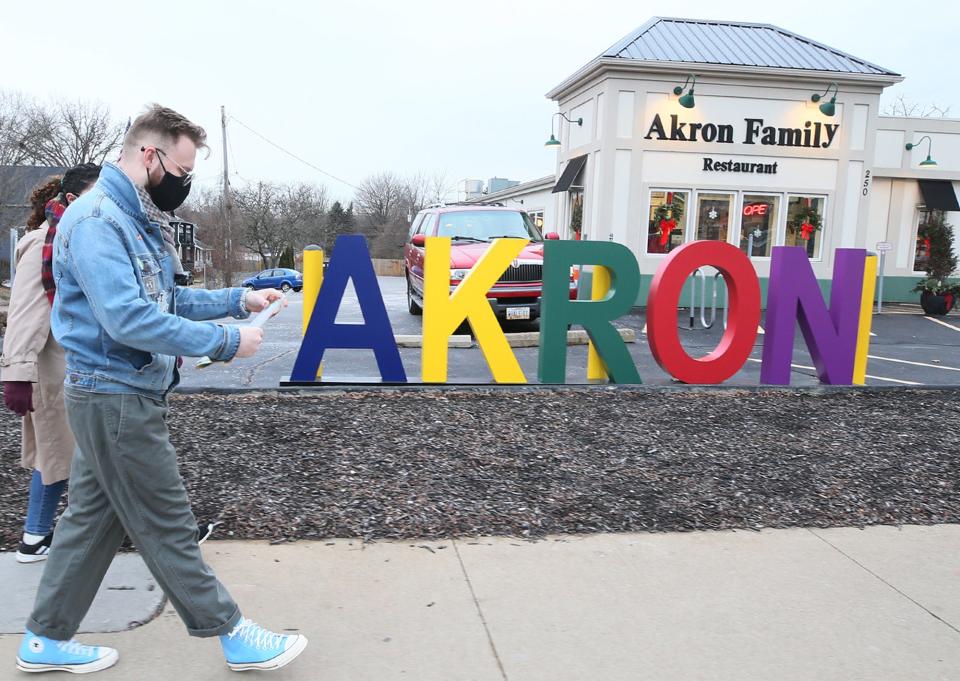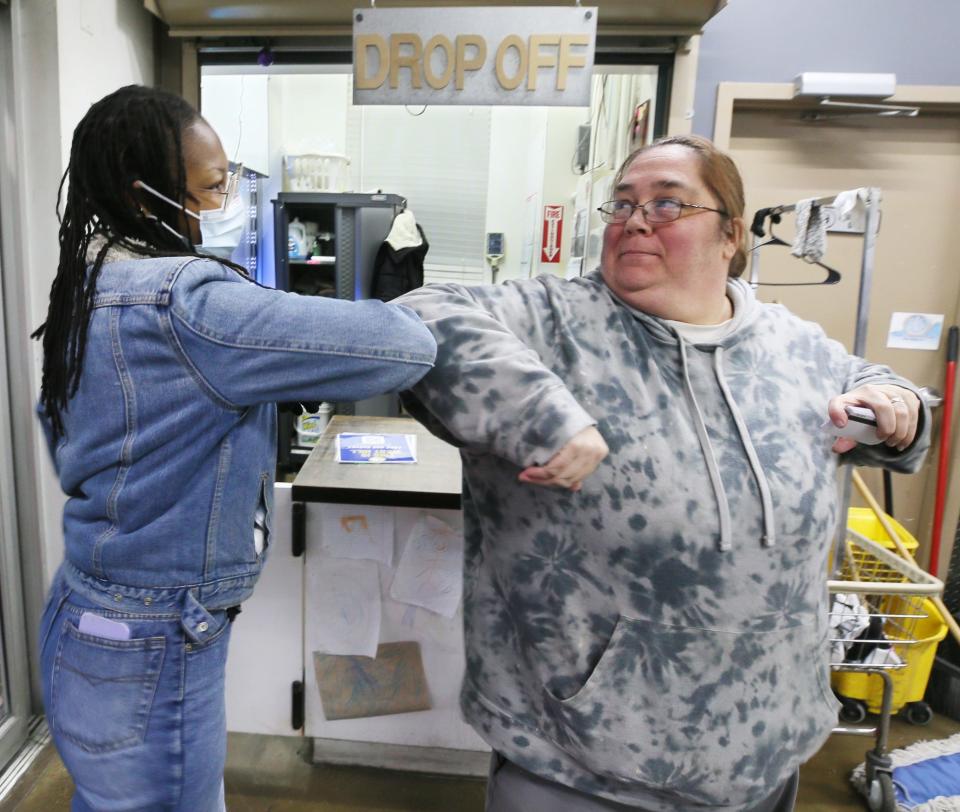West Hill task force canvasses Akron neighborhood to assess needs, provide direct aid

When Josy Jones walked into a laundromat on a Thursday night with a stack of free bus passes, manager Becky Bydo’s face lit up.
“I could just hug you right now,” she told Jones.
It’s a simple thing, really, but Bydo insists that kindness from a neighbor not only changed her entire night, but weeks to come.
“My husband has a doctor’s appointment tomorrow and we were really stressing about how to get there,” she said. “And in here, I see people from all walks of life. There have been times I’ve handed people my own cash for the bus. Now I can just give them one of these.”
The stop at the laundromat was part of a greater canvassing and outreach effort by Jones and three other neighbors who calls themselves the “West Hill Comeback Task Force.”
“We’re really trying to revolutionize how community advocacy is done,” said Fran Wilson, a 26-year-old West Hill resident.
With a $20,000 grant from Akron City Council’s COVID relief funds, the group banded together under West Hill Neighborhood Organization, the neighborhood’s community development corporation, to provide direct aid and community programming for the residents and set the stage for bigger plans on the horizon.

Addressing direct needs through canvassing and surveying
The group received the grant from City Council in November. The goal was to address immediate needs related to the pandemic, while also using the opportunity to gain a better insight as to who lived in the neighborhood and what long-term goals they had for it.
“I do not have a title under West Hill Neighborhood Organization,” Wilson said. “I'm just a neighbor who cares a lot about our community and wants to see the possibilities for West Hill if basic needs are met.”
To get an accurate assessment of those needs, the team has spent months going door-to-door canvassing homes to gather data from neighbors to inform programming.
The group has also posted flyers in highly-trafficked West Hill businesses and at bus stops with a QR code to take an online survey. To incentivize as many people to answer as possible, particularly low-income residents who tend to be left out of community organizing, the flyer promotes the possibility of winning free bus passes. A targeted texting campaign also promotes the survey, collects data and spreads positive messaging.
“We need to meet people where they’re at, especially in blighted and under-resourced neighborhoods,” Wilson said.
The survey begins by collecting basic demographic and identification questions, including price of rent, cost of utilities and sliding scale to rate tenant’s relationships with landlords for the 72% of the neighborhood’s population that are renters.
Similar to much of Akron, a majority of the housing stock predates the 1940s: an issue that particularly plagues the neighborhood as it was one of the first established in the city. Residents can indicate in the survey if they are in need of car or home repairs for things such as kitchen, bathroom or roof fixes. Wilson said the group is currently seeking further funding and grants to provide that aid to the people who indicated they need it.
Neighbors are also prompted to answer questions about what their favorite and least favorite thing about the neighborhood is, where they spend their free time, what sorts of businesses they’d like to see in the neighborhood, if they’re considering opening a business and if they’d like to volunteer for community events.
To offset some of the significant economic challenges throughout the pandemic, the group has also distributed hundreds of bus passes and grocery cards.
“I am quite excited to see the long term impacts of simple things like handing out bus cards,” Wilson said. “Anybody who has lived in poverty or relied on public transportation knows a bus ticket has a profound impact on somebody’s day and their well-being.”

Creating an engaged community in ‘disconnected’ neighborhood ‘bursting with potential’
West Hill is situated between two of Akron’s most central social and economically prosperous communities: Downtown and Highland Square. Despite its benefits, being juxtaposed to these two hubs can cause an identity issue for the neighborhood, especially because of its geographic challenges, such as the Innerbelt separating it from downtown.
“West Hill is a funny neighborhood being so close to Highland Square and downtown, but people not actually feeling connected to those places,” said David Swirsky, a member of the task force. “There’s a lot of opportunity, it’s just connecting the dots.”
Through canvassing, Jones has also discovered a lot of people in the neighborhood “don’t even know what West Hill is.”
“We’re more of a pass-through neighborhood versus trying to come here to do something,” Jones said. “Currently, anyway.”
And the neighborhood’s population, she’s found, is relatively transient.
“When people don’t stay in neighborhoods, it’s because they don’t feel at home in that neighborhood,” she said. “We see this as a really cool place that could be unique in the city of Akron. We want people here to see that too.”
Jones had unofficially been canvassing the neighborhood since she moved to Akron in January 2017. The playwright and performer has used her art to catalyze community engagement and inform her work. A lot of her art has centered on a special live-work zoning code specific to West Hill, which allows residents to operate a business out of their homes.
“Not a lot of people have an understanding of what it is or are taking advantage of it,” Jones said. “And we need more gathering spaces to combat that disconnectedness. There are places you could come to, but with the [live-work zoning], it’s ripe for change or for things to be even better.”
As the organization works on those long-term visions for the neighborhood, they are looking at simpler ways to spur community engagement more immediately.
Funds from the City Council grant are being used to bolster existing projects, such as constructing picnic tables in the Oakdale Pocket Park. The task force has also organized community events in recent months, including fall and winter fests at the pocket park and Balch Street Theater with activities and snacks.
As for future steps, it all depends on what they learn through their survey.
“It’s about working with a community, not for a community, and that process takes longer,” Jones said. “The CDC could just say, ‘I’m going to develop this thing and tell no one’ versus taking the longer route, which is what we’re doing, and the impact lasts a lot longer.”
Reporter Abbey Marshall is a corps member with Report for America, a national service program that places journalists into local newsrooms. Learn more at reportforamerica.org. Contact her at at amarshall1@gannett.com.
This article originally appeared on Akron Beacon Journal: West Hill residents provide direct pandemic aid to neighbors

